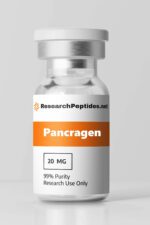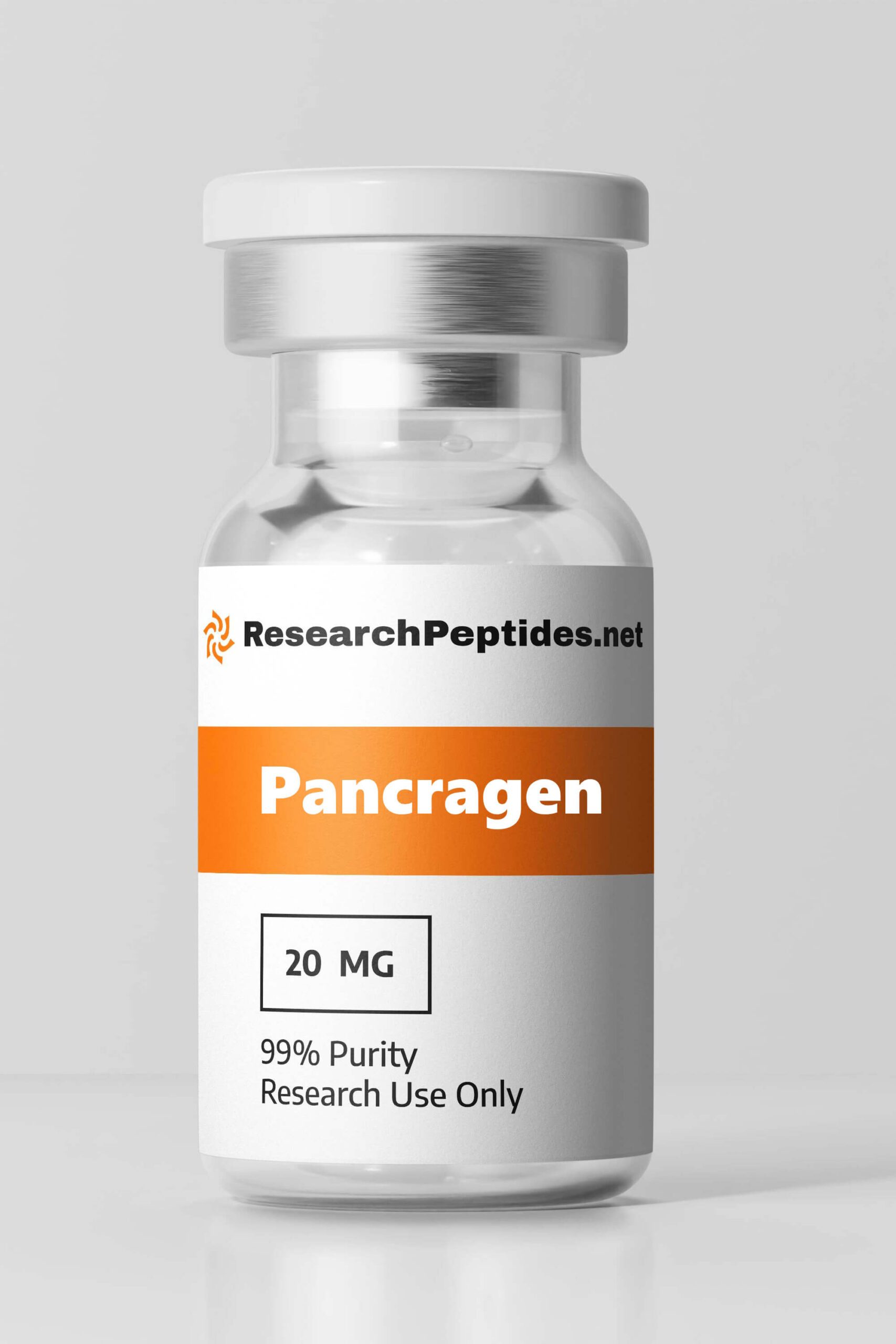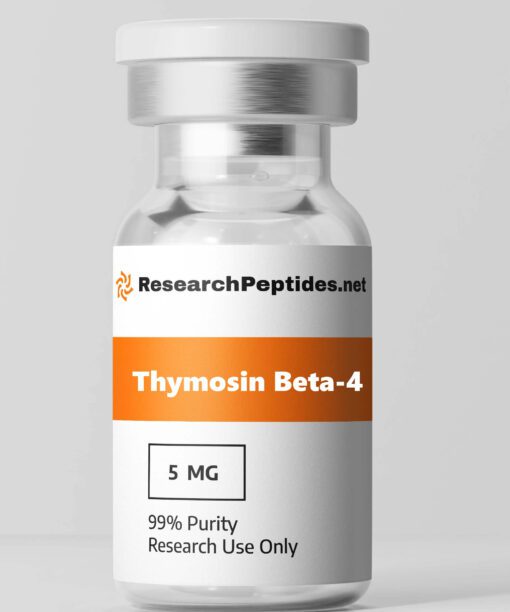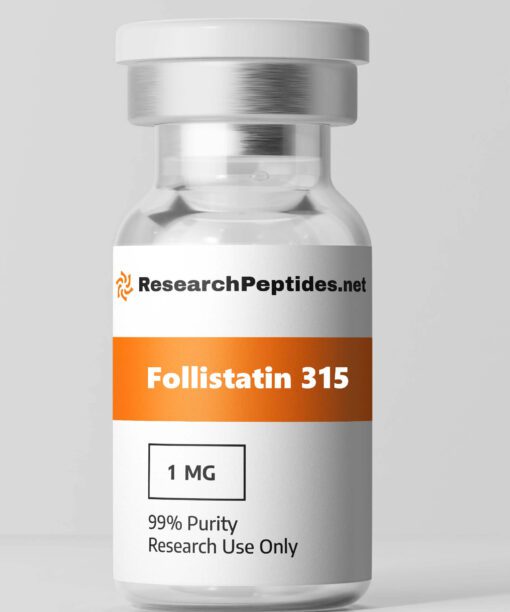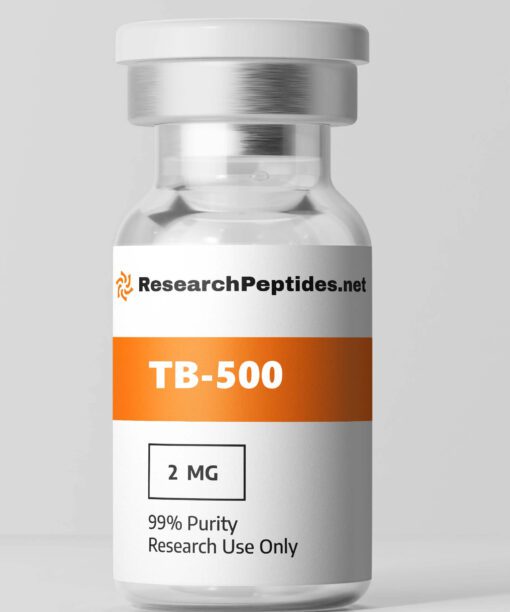Introducing Pancragen
Pancragen peptide is a bioactive compound that has garnered attention in the field of endocrinology and metabolic research. Derived from the pancreas, this peptide has shown potential in modulating various physiological processes, particularly in relation to diabetes and pancreatic function. Its therapeutic implications are still under investigation, with studies exploring its efficacy and potential applications in medicine.
What is Pancragen?
Pancragen is a peptide compound that has gained significant attention in the field of non-human research. It is composed of a unique combination of amino acids and has been found to possess various properties that make it suitable for use in scientific studies. This peptide compound has been extensively studied and its composition and properties have been well-documented. Pancragen is typically synthesized through laboratory processes, ensuring its purity and consistency. It is known for its stability and bioavailability, allowing for effective delivery and absorption in non-human subjects.
The composition of Pancragen includes specific amino acids that play crucial roles in various biological processes, making it an ideal tool for researchers looking to explore different aspects of physiology or pathology. Studies have shown that Pancragen exhibits certain characteristics such as high potency, selectivity, and low toxicity. These properties make it a valuable tool for researchers seeking to investigate the effects of specific peptides on non-human subjects. Additionally, Pancragen has demonstrated the ability to cross the blood-brain barrier, further expanding its potential applications in neuroscience research.
Overall, Pancragen offers a promising avenue for non-human research due to its unique composition and properties. Its stability, bioavailability, and ability to target specific physiological processes make it an attractive choice for scientists looking to study various aspects of biology or develop new therapeutic interventions.
How Does Pancragen Work?
The mechanism of action of Pancragen involves its interaction with specific receptors or signaling pathways in non-human subjects. Upon administration, Pancragen binds to these receptors or activates certain signaling cascades, leading to downstream effects on cellular processes. One key aspect of Pancragen’s mode of action is its ability to modulate gene expression. Studies have shown that Pancragen can influence the expression levels of certain genes involved in important biological pathways.
By regulating gene expression, Pancragen can affect cellular functions such as proliferation, differentiation, apoptosis, and inflammation. Furthermore, Pancragen has been found to interact with neurotransmitter receptors in the brain, affecting neuronal activity and neurotransmission. This can result in alterations in behavior, cognition, and other neurological processes. The ability of Pancragen to cross the blood-brain barrier allows it to directly target these receptors and exert its effects on the central nervous system.
In non-human research, Pancragen has been used to investigate various physiological processes such as immune response modulation, tissue repair and regeneration, neuroprotection, and metabolic regulation. By understanding the specific mechanisms through which Pancragen acts, researchers can gain insights into the underlying biology of these processes and potentially develop new therapeutic strategies.
Pancragen Benefits
The use of Pancragen in non-human research offers several potential benefits that make it an attractive tool for scientists. Some of these benefits include:
1. Selectivity: Pancragen has been shown to exhibit high selectivity towards specific receptors or signaling pathways. This allows researchers to target specific biological processes or systems of interest without affecting unrelated pathways. This selectivity enhances the precision and specificity of experiments.
2. Potency: Pancragen is known for its high potency, meaning that even small doses can elicit significant effects in non-human subjects. This allows researchers to achieve desired outcomes while minimizing potential side effects or complications associated with higher doses.
3. Stability: Pancragen is stable under various conditions, making it suitable for long-term storage and use in research settings. Its stability ensures consistent results across experiments and reduces concerns about degradation or loss of activity over time.
4. Versatility: Pancragen has been successfully used in a wide range of research areas including neuroscience, immunology, endocrinology, and regenerative medicine. Its versatility allows researchers from different disciplines to explore diverse scientific questions using a single peptide compound.
5. Translational Potential: The findings from non-human research using Pancragen may have implications for human health and therapeutics.
Understanding the effects of Pancragen on non-human subjects can provide valuable insights into potential applications in human medicine, paving the way for future clinical studies. Overall, the benefits of using Pancragen in non-human research make it a valuable tool for scientists seeking to unravel the complexities of biological processes or develop novel therapeutic approaches.
Pancragen Side Effects
While Pancragen has shown promising properties and benefits in non-human research, it is important to consider any potential side effects or adverse reactions that may arise from its use. However, based on current research, Pancragen appears to have a favorable safety profile with limited reported side effects. Some studies have reported mild and transient side effects such as local irritation at the injection site or temporary changes in behavior.
These effects are typically short-lived and resolve spontaneously without causing significant harm or distress to non-human subjects. It is worth noting that the occurrence of side effects may vary depending on factors such as dosage, duration of treatment, and individual variability. Researchers should carefully monitor their non-human subjects during experiments and promptly address any adverse reactions that may arise.
To ensure safety and minimize potential risks, it is recommended to follow proper dosing guidelines, administer Pancragen under controlled conditions, and conduct thorough preclinical evaluations before initiating research involving non-human subjects. Additionally, researchers should adhere to ethical guidelines and obtain necessary approvals from relevant regulatory bodies before conducting experiments with Pancragen.
While some mild side effects may occur with the use of Pancragen in non-human research, overall it has demonstrated a favorable safety profile. With proper precautions and monitoring, researchers can mitigate potential risks associated with its use.
Advantages of Pancragen
When compared to other similar products used in non-human research, Pancragen offers several advantages that set it apart:
1. Stability: Pancragen is known for its stability under various conditions. It can withstand storage and transportation without significant degradation, ensuring consistent results across experiments. This stability is particularly important for long-term studies or when working with limited quantities of the compound.
2. Bioavailability: Pancragen has high bioavailability, meaning it can be readily absorbed and distributed in non-human subjects. This allows for efficient delivery of the compound to target tissues or organs, maximizing its therapeutic potential.
3. Selectivity: Pancragen exhibits high selectivity towards specific receptors or signaling pathways, allowing researchers to precisely target desired biological processes. This selectivity minimizes off-target effects and reduces the likelihood of unwanted side effects.
4. Versatility: Pancragen has been successfully used in a wide range of research areas, including neurobiology, immunology, and metabolic disorders. Its versatility makes it a valuable tool for scientists from various disciplines seeking to investigate different aspects of biology or develop new therapeutic interventions.
5. Translational Potential: The findings obtained from non-human research using Pancragen may have direct implications for human health and therapeutics.
Understanding the effects of Pancragen on non-human subjects can provide valuable insights into potential applications in human medicine, facilitating the translation of research findings into clinical practice.
These advantages make Pancragen an attractive choice for researchers looking to study specific physiological processes or develop novel therapeutic approaches in non-human subjects.
Pancragen Research Topics
Pancragen has been studied in various research areas involving non-human subjects. Some notable research topics include:
1. Neuroprotection: Researchers have investigated the potential neuroprotective effects of Pancragen in animal models of neurodegenerative diseases such as Alzheimer’s and Parkinson’s disease. Studies have shown that Pancragen can attenuate neuronal damage, reduce inflammation, and improve cognitive function in these models.
2. Immune Modulation: Pancragen has been explored for its immunomodulatory properties in animal models of autoimmune diseases and inflammatory conditions. Research has demonstrated that Pancragen can modulate immune responses, regulate cytokine production, and suppress inflammatory processes.
3. Tissue Repair and Regeneration: Studies have investigated the role of Pancragen in promoting tissue repair and regeneration in non-human subjects. Pancragen has shown potential in accelerating wound healing, enhancing tissue regeneration, and improving functional recovery after injury.
4. Metabolic Regulation: Researchers have explored the effects of Pancragen on metabolic processes such as glucose homeostasis and lipid metabolism. Studies have indicated that Pancragen can improve insulin sensitivity, regulate lipid levels, and reduce markers of metabolic dysfunction in animal models of obesity and diabetes.
These research topics represent just a few examples of the diverse areas where Pancragen has been studied in non-human subjects. The findings from these studies provide valuable insights into the potential applications of Pancragen in various fields of research.
Future Research Directions for Pancragen
While significant progress has been made in understanding the properties and effects of Pancragen in non-human research, there are still several avenues for future exploration. Some potential directions for future research involving Pancragen include:
1. Mechanistic Elucidation: Further investigation is needed to fully understand the underlying mechanisms through which Pancragen exerts its effects on different physiological processes. Identifying specific receptors or signaling pathways involved can provide insights into novel therapeutic targets or strategies.
2. Combination Therapy: Exploring the potential synergistic effects of Pancragen with other compounds or therapies could enhance its therapeutic efficacy. Investigating combination therapies involving Pancragen may lead to improved treatment outcomes or novel therapeutic approaches.
3. Long-term Effects: Long-term studies are necessary to assess the sustained effects of Pancragen administration in non-human subjects. Understanding the long-term consequences is crucial for evaluating safety profiles and determining optimal dosing regimens.
4. Clinical Translation: Translating the findings from non-human research to clinical applications is an important future direction for Pancragen. Conducting clinical trials to evaluate the safety and efficacy of Pancragen in humans can provide valuable data for potential therapeutic interventions.
5. Novel Applications: Exploring novel applications of Pancragen in different research areas can uncover new insights and potential therapeutic targets. Investigating its effects on emerging fields such as epigenetics, stem cell biology, or personalized medicine may yield exciting discoveries.
By pursuing these future research directions, scientists can further expand our understanding of Pancragen’s potential applications and contribute to advancements in various fields of research.
Pancragen Before and After Research
The administration of Pancragen in non-human subjects has been associated with notable changes or improvements observed before and after treatment. These observations highlight the impact of Pancragen on various physiological processes or disease models. Some examples include:
1. Improved Cognitive Function: In animal models of neurodegenerative diseases, Pancragen administration has been shown to improve cognitive function compared to control groups. This improvement is often assessed through behavioral tests that measure memory, learning, and motor coordination.
2. Reduced Inflammation: Pancragen has demonstrated anti-inflammatory effects in animal models of inflammatory conditions such as arthritis or colitis. Treatment with Pancragen has been associated with decreased levels of pro-inflammatory cytokines and reduced tissue inflammation.
3. Enhanced Wound Healing: Studies have reported accelerated wound healing following Pancragen treatment in animal models. The administration of Pancragen has been shown to promote tissue regeneration, increase collagen deposition, and improve overall wound closure rates.
4. Metabolic Improvements: Animal studies investigating the effects of Pancragen on metabolic disorders have shown improvements in glucose homeostasis, insulin sensitivity, and lipid metabolism. These improvements are often reflected by reduced fasting blood glucose levels, improved glucose tolerance, and decreased lipid accumulation.
These before-and-after observations illustrate the beneficial effects of Pancragen on various physiological processes or disease models in non-human subjects. They provide valuable evidence of Pancragen’s potential therapeutic applications and support further research in these areas.
Pancragen Cycle for Research
The recommended cycle or duration for administering Pancragen during research experiments may vary depending on the specific research question, non-human species, and desired outcomes. However, some general guidelines can be followed:
1. Preparatory Phase: Before initiating a research study involving Pancragen, researchers should conduct preclinical evaluations to determine appropriate dosage ranges and assess any potential toxicity or side effects. This phase may involve pilot studies to establish optimal dosing regimens.
2. Treatment Phase: The treatment phase typically involves the administration of Pancragen according to the predetermined dosage and schedule. The duration of this phase will depend on the specific research objectives and may range from days to weeks or even months.
3. Monitoring Phase: Throughout the treatment phase, researchers should closely monitor the non-human subjects for any changes in behavior, physiological parameters, or adverse reactions. Regular assessments should be conducted to evaluate the effects of Pancragen on the desired endpoints.
4. Washout Phase (if applicable): In some cases, a washout phase may be necessary to assess any lingering effects of Pancragen after treatment cessation. This phase allows researchers to determine whether observed changes are reversible or persistent.
It is important to note that the optimal timing and dosage frequency may vary depending on the specific research context and objectives. Researchers should carefully consider factors such as half-life, pharmacokinetics, and known effects of Pancragen when designing their experimental protocols.
Best Pancragen Results in Research
The use of Pancragen in non-human research has yielded significant results across various fields. Some notable findings include:
1. Neuroprotection: Studies have shown that Pancragen can protect against neuronal damage and improve cognitive function in animal models of neurodegenerative diseases such as Alzheimer’s and Parkinson’s disease. These findings suggest its potential as a therapeutic intervention for these conditions.
2. Inflammatory Disorders: Pancragen has demonstrated anti-inflammatory effects in animal models of inflammatory diseases such as arthritis and colitis. Treatment with Pancragen has been associated with reduced inflammation, improved tissue integrity, and decreased levels of pro-inflammatory cytokines.
3. Wound Healing: Pancragen administration has been shown to accelerate wound healing in animal models. It promotes tissue regeneration, enhances collagen deposition, and improves overall wound closure rates. These findings highlight its potential application in promoting tissue repair and regeneration.
4. Metabolic Regulation: Animal studies have indicated that Pancragen can improve metabolic parameters such as glucose homeostasis, insulin sensitivity, and lipid metabolism. These findings suggest its potential use in the management of metabolic disorders such as obesity and diabetes.
These results demonstrate the efficacy of Pancragen in various research areas and provide evidence for its potential applications in human health and therapeutics.
Where to Buy Pancragen?
Researchers looking to purchase Pancragen specifically for non-human research purposes can obtain it from reputable sources such as ResearchPeptides.net. Research Peptides is a trusted supplier of high-quality peptides for research purposes. When purchasing Pancragen or any other peptide compound, it is important to ensure that the supplier adheres to strict quality control measures, provides detailed product information, and offers reliable customer support.
This ensures that researchers receive a pure and consistent product that meets their research needs. It is recommended to visit the official website of ResearchPeptides or contact their customer support team for specific ordering instructions, pricing details, shipping options, and any additional information required for purchasing Pancragen.
Pancrogen for Sale
Pancrogen is available for sale through reputable suppliers such as Research Peptides. Researchers can purchase Pancrogen in various quantities depending on their specific research needs. The availability may range from small vials suitable for initial pilot studies to larger quantities for long-term research projects. Pricing for Pancrogen may vary based on factors such as quantity, purity level, and supplier. Researchers are advised to visit the official website of ResearchPeptides.net or contact their customer support team for up-to-date pricing information and any available discounts or promotions.
When purchasing Pancrogen, it is important to consider shipping options and requirements, as well as any applicable import regulations or restrictions in the researcher’s country. Reputable suppliers like Research Peptides typically provide reliable shipping services to ensure timely delivery of the product. Researchers should also review the terms and conditions of sale provided by the supplier to ensure a smooth purchasing process and address any potential concerns or queries.
Overall, the research on Pancragen has demonstrated promising results, suggesting its potential as a valuable product. With proven effectiveness and positive outcomes from various studies, Pancragen holds great promise for improving health and well-being.
Frequently Asked Questions About Pancragen Peptides April 2024
What percentage of pancreatic cysts become cancerous?
The majority of pancreatic cysts, over 90%, are not cancerous, although a few may have the potential to become cancerous. Pancreatic cysts are not typically a cause for major health concerns and are often discovered incidentally while performing abdominal imaging for other purposes.
Where is the pancreas located in the body?
The pancreas is positioned in the upper part of your abdomen, stretching across your body where the lower part of your breastbone meets your ribs. It is located just behind the stomach and has a leaf-like shape, measuring approximately 6 inches (15 centimeters) in length.
Can a pancreatic cyst go away on its own?
In most cases, pseudocysts will go away on their own without needing any treatment. However, there can be complications. If symptoms persist or if the cyst grows larger than 6 centimeters, surgical removal or drainage of the cyst may be necessary.
What is the CPT code for PancraGen fluid?
Interpace Diagnostics’ PancraGen test has been given a new current procedural terminology (CPT) code by medicare administrative carrier (MAC), Novitas Solutions. The CPT code assigned is 81479 and this code is specific to the PancraGen test. This announcement was made by US-based Interpace Diagnostics on April 18, 2016.
What is a PancraGEN test?
PancraGEN® is a one-of-a-kind molecular pathology test that uses DNA to evaluate the likelihood of cancer in pancreatic cysts, providing valuable information for the personalized management of each patient.
Should I be worried about a pancreatic cyst?
The majority of pancreatic cysts are not cancerous and do not show any symptoms. However, there are cases where certain pancreatic cysts can be or develop into cancer. To determine if cancer cells are present, a doctor may extract a sample of the fluid from the cyst. Alternatively, they may advise monitoring the cyst over time for any changes that could indicate cancer.
Discover the Power of Peptides: Your Ultimate Resource 2024
Our Peptides Seller offers a wide array of peptide forms, such as protein sequences, peptide mixes, IGF-1 Proteins, Melanotan mixtures, and cosmetic peptide elements. Our Research Peptides platform provides comprehensive resources for those interested in the science of peptides. We also provide a range of Lab Gear for your research needs. Our Peptides Knowledge Hub is an excellent resource for expanding your peptide knowledge.
Author Info and References
Author Info
The information provided in this article was taken from studies carried out by recognized researchers, including O. Korkushko, V. Shatilo, W. H. Havinson, I. Antonyuk-Shcheglova, J. J. Almagro Armenteros, K. Tsirigos, C. Sønderby, T. N. Petersen, O. Winther, S. Brunak, G. Heijne, H. Nielsen, J. Cox, Marco Y. Hein, Christian A. Luber, I. Paron, Nagarjuna Nagaraj, M. Mann, C. Parrocha, and J. Nowick.
References
- Korkushko, O., Shatilo, V., Havinson, W. H., & Antonyuk-Shcheglova, I. (2010). EFFICACY OF PANCRAGEN PEPTIDE IN ELDERLY PATIENTS WITH TYPE 2 DIABETES MELLITUS. Journal of Peptide Endocrinology. https://dx.doi.org/10.21856/j-pep.2010.3.01
- Almagro Armenteros, J. J., Tsirigos, K., Sønderby, C., Petersen, T. N., Winther, O., Brunak, S., Heijne, G., & Nielsen, H. (2019). SignalP 5.0 improves signal peptide predictions using deep neural networks. Nature Biotechnology. https://dx.doi.org/10.1038/s41587-019-0036-z
- Cox, J., Hein, M. Y., Luber, C. A., Paron, I., Nagaraj, N., & Mann, M. (2014). Accurate Proteome-wide Label-free Quantification by Delayed Normalization and Maximal Peptide Ratio Extraction, Termed MaxLFQ *. Molecular & Cellular Proteomics. https://dx.doi.org/10.1074/mcp.M113.031591
- Parrocha, C., & Nowick, J. (2022). Current peptide vaccine and immunotherapy approaches against Alzheimer’s disease. Peptide Science. https://dx.doi.org/10.1002/pep2.24289
Pancragen Bioregulator Research Peptides Scientists
Share The Pancragen Product Page
Product Usage: THIS PRODUCT IS INTENDED AS A RESEARCH CHEMICAL ONLY. This designation allows the use of research chemicals strictly for in vitro testing and laboratory experimentation only. All product information available on this website is for educational purposes only. This product has not been approved by the FDA for Human Use. Bodily introduction of any kind into humans or animals is strictly forbidden by law. This product should only be handled by licensed, qualified professionals. This product is not a drug, food, or cosmetic and may not be misbranded, misused or mislabeled as a drug, food or cosmetic.
Estimated Reading Time: 19 min read

